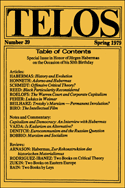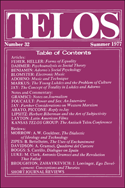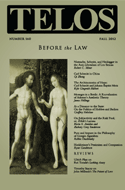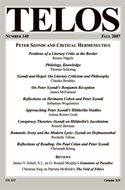By Matt Applegate · Tuesday, December 17, 2013 As an occasional feature on TELOSscope, we highlight a past Telos article whose critical insights continue to illuminate our thinking and challenge our assumptions. Today, Matt Applegate looks at Yvette Biro’s “The Intellectual Film: Eisenstein’s Plan to Film Marx’s Capital“ from Telos 39 (Spring 1979).
 It is difficult to think of what cinema is in the present, and indeed, what cinema might be in the future, outside of large studio systems, box office opening numbers, and global profit intake. Even so-called “independent” films often circulate in a virtual minor league of the Hollywood studio system, vying for wide release. To be sure, cinema’s thorough commodification both limits its potential for aesthetic experimentation and makes it easier to equate it with other forms of media. When cinema becomes secondary to the metrics of profit, its distinct aesthetic qualities are subordinate to its function as a product comprised of moving images and sound. Moreover, as film moves away from celluloid and toward digital formats, one is compelled to ask what makes cinema distinct as visual technology is homogenized. This is not to say that cinematic experience and practice are bankrupt aesthetic qualities or that film is doomed to devolve into an indistinct mesh of CGI and user-generated websites like YouTube and Vine. Rather, as Yvette Biro suggests in her “The Intellectual Film: Eisenstein’s Plan to Film Marx’s Capital,” the horizon of cinematic thought and practice is perhaps best imagined by examining the relation between ideology and cinematic aesthetics. It is difficult to think of what cinema is in the present, and indeed, what cinema might be in the future, outside of large studio systems, box office opening numbers, and global profit intake. Even so-called “independent” films often circulate in a virtual minor league of the Hollywood studio system, vying for wide release. To be sure, cinema’s thorough commodification both limits its potential for aesthetic experimentation and makes it easier to equate it with other forms of media. When cinema becomes secondary to the metrics of profit, its distinct aesthetic qualities are subordinate to its function as a product comprised of moving images and sound. Moreover, as film moves away from celluloid and toward digital formats, one is compelled to ask what makes cinema distinct as visual technology is homogenized. This is not to say that cinematic experience and practice are bankrupt aesthetic qualities or that film is doomed to devolve into an indistinct mesh of CGI and user-generated websites like YouTube and Vine. Rather, as Yvette Biro suggests in her “The Intellectual Film: Eisenstein’s Plan to Film Marx’s Capital,” the horizon of cinematic thought and practice is perhaps best imagined by examining the relation between ideology and cinematic aesthetics.
Continue reading →
By J. F. Dorahy · Tuesday, March 5, 2013 As an occasional feature on TELOSscope, we highlight a past Telos article whose critical insights continue to illuminate our thinking and challenge our assumptions. Today, J.F. Dorahy looks at György Márkus’s “The Soul and Life: The Young Lukács and the Problem of Culture,” from Telos 32 (Summer 1977).
 György Márkus’s essay on Lukács, “The Soul and Life,” is a seminal insight into one of the most influential philosophical oeuvres of the twentieth century. This piece, published at a time when only a handful of Márkus’s papers were available to English-language readers, reflects an intimacy with Lukács’s aesthetics that is unsurpassed in Lukács scholarship. (Márkus jointly edited, along with Frank Benesler, Lukács’s posthumously published Heidelberger Philosophie der Kunst 1916–18 and the Heidelberger Ästhetik 1916–1918, works that figure prominently in the essay under consideration.) The discussion in “The Soul and Life” centers on the problem of the possibility of culture as treated by Lukács in his pre-1918, or pre-Marxist, writings. György Márkus’s essay on Lukács, “The Soul and Life,” is a seminal insight into one of the most influential philosophical oeuvres of the twentieth century. This piece, published at a time when only a handful of Márkus’s papers were available to English-language readers, reflects an intimacy with Lukács’s aesthetics that is unsurpassed in Lukács scholarship. (Márkus jointly edited, along with Frank Benesler, Lukács’s posthumously published Heidelberger Philosophie der Kunst 1916–18 and the Heidelberger Ästhetik 1916–1918, works that figure prominently in the essay under consideration.) The discussion in “The Soul and Life” centers on the problem of the possibility of culture as treated by Lukács in his pre-1918, or pre-Marxist, writings.
Continue reading →
By James Hellings · Monday, October 15, 2012 James Hellings’s “Messages in a Bottle and Other Things Lost to the Sea: The Other Side of Critical Theory or a Reevaluation of Adorno’s Aesthetic Theory” appears in Telos 160 (Fall 2012). Read the full version online at the Telos Online website, or purchase a print copy of the issue here.
 Drawing on a range of modern and contemporary works of art and literature (Edgar Allan Poe, Caspar David Friedrich, Bas Jan Ader, Tacita Dean), this essay seeks to exaggerate the aesthetic side of Adorno’s critical theory, re-evaluating the latter through a detailed analysis of the image of messages in a bottle. In overturning and displacing the critical genealogy of this image and in anchoring it to the construction of Adorno’s aesthetic and the work of art, I challenge the so-called “prevalent view” that transforms Adorno’s image into a pejorative logo for his alleged withdrawal into political quietism, pessimism, and resignation: a “strategy of hibernation.” Neither the critical theorists nor the activist critics of the Frankfurt School, I argue, have exclusivity over the image of messages in a bottle. If art is “the surviving message of despair from the shipwrecked,” then the work of art in Adorno’s aesthetics best expresses the paradox of engagement through disengagement, which itself translates Adorno’s standpoint on social praxis. Art turns socio-political, as with Friedrich’s Rückenfiguren, by turning away. Adorno valued radical new art for its distancing effect, for its great refusal, for becoming society’s Other. Art works well when complex antagonistic fragments crystallize into a force field, confronting, critiquing, and transforming the damaged life of society. Art, like the bottle of messages, is a container for truth and hope addressed to imaginary witnesses of an uncertain future, sent in spite of the aggressive indifference of the world, and aesthetics becomes, here at least, the privileged other of critical theory. Drawing on a range of modern and contemporary works of art and literature (Edgar Allan Poe, Caspar David Friedrich, Bas Jan Ader, Tacita Dean), this essay seeks to exaggerate the aesthetic side of Adorno’s critical theory, re-evaluating the latter through a detailed analysis of the image of messages in a bottle. In overturning and displacing the critical genealogy of this image and in anchoring it to the construction of Adorno’s aesthetic and the work of art, I challenge the so-called “prevalent view” that transforms Adorno’s image into a pejorative logo for his alleged withdrawal into political quietism, pessimism, and resignation: a “strategy of hibernation.” Neither the critical theorists nor the activist critics of the Frankfurt School, I argue, have exclusivity over the image of messages in a bottle. If art is “the surviving message of despair from the shipwrecked,” then the work of art in Adorno’s aesthetics best expresses the paradox of engagement through disengagement, which itself translates Adorno’s standpoint on social praxis. Art turns socio-political, as with Friedrich’s Rückenfiguren, by turning away. Adorno valued radical new art for its distancing effect, for its great refusal, for becoming society’s Other. Art works well when complex antagonistic fragments crystallize into a force field, confronting, critiquing, and transforming the damaged life of society. Art, like the bottle of messages, is a container for truth and hope addressed to imaginary witnesses of an uncertain future, sent in spite of the aggressive indifference of the world, and aesthetics becomes, here at least, the privileged other of critical theory.
Continue reading →
Telos 140: Peter Szondi and Critical Hermeneutics is available in our store.
 Literature has been a long-standing, if sometimes hidden, topic for Telos. While the journal has ostensibly focused on social and political theory, in various traditions and stretching from philosophy to culture, matters of literature have frequently percolated between the lines. This interlinear presence has certainly been the case for our engagements with those thinkers who made major contributions to literary and aesthetic theory, such as Adorno, as well as Baudrillard, Benjamin, Goldmann, Gramsci, and Lukács, but more broadly to the wide-ranging efforts to interpret and reinterpret works of the past: Telos has been about rereading, recovering, and reinterpreting parts of the intellectual legacy with reference to questions of current urgency. While the journal did succeed in keeping a healthy distance of common sense from the vanity fair of “literary theory” that gripped the universities during the 1980s and 1990s, our interest in mapping alternatives to the mentalities of bureaucracy—traditions, communities, the life-world, and religion—also indicated an underlying interest in literature, as well as in the arts in general. This testifies, of course, to the legacy of Critical Theory and the effort to correct the dominance of instrumental reason with an aesthetic dimension; but there is a much bigger picture, beyond the specific confines of Critical Theory per se, the pursuit of a richer life and a resistance to all the cultural and social forces that degrade human creativity and freedom, whether one attributes them to modernity or to conditions of longer duration. As a vehicle that can enhance imagination and expressivity, literature turns out to be indispensable. Literature has been a long-standing, if sometimes hidden, topic for Telos. While the journal has ostensibly focused on social and political theory, in various traditions and stretching from philosophy to culture, matters of literature have frequently percolated between the lines. This interlinear presence has certainly been the case for our engagements with those thinkers who made major contributions to literary and aesthetic theory, such as Adorno, as well as Baudrillard, Benjamin, Goldmann, Gramsci, and Lukács, but more broadly to the wide-ranging efforts to interpret and reinterpret works of the past: Telos has been about rereading, recovering, and reinterpreting parts of the intellectual legacy with reference to questions of current urgency. While the journal did succeed in keeping a healthy distance of common sense from the vanity fair of “literary theory” that gripped the universities during the 1980s and 1990s, our interest in mapping alternatives to the mentalities of bureaucracy—traditions, communities, the life-world, and religion—also indicated an underlying interest in literature, as well as in the arts in general. This testifies, of course, to the legacy of Critical Theory and the effort to correct the dominance of instrumental reason with an aesthetic dimension; but there is a much bigger picture, beyond the specific confines of Critical Theory per se, the pursuit of a richer life and a resistance to all the cultural and social forces that degrade human creativity and freedom, whether one attributes them to modernity or to conditions of longer duration. As a vehicle that can enhance imagination and expressivity, literature turns out to be indispensable.
Continue reading →
|
|
 It is difficult to think of what cinema is in the present, and indeed, what cinema might be in the future, outside of large studio systems, box office opening numbers, and global profit intake. Even so-called “independent” films often circulate in a virtual minor league of the Hollywood studio system, vying for wide release. To be sure, cinema’s thorough commodification both limits its potential for aesthetic experimentation and makes it easier to equate it with other forms of media. When cinema becomes secondary to the metrics of profit, its distinct aesthetic qualities are subordinate to its function as a product comprised of moving images and sound. Moreover, as film moves away from celluloid and toward digital formats, one is compelled to ask what makes cinema distinct as visual technology is homogenized. This is not to say that cinematic experience and practice are bankrupt aesthetic qualities or that film is doomed to devolve into an indistinct mesh of CGI and user-generated websites like YouTube and Vine. Rather, as Yvette Biro suggests in her “The Intellectual Film: Eisenstein’s Plan to Film Marx’s Capital,” the horizon of cinematic thought and practice is perhaps best imagined by examining the relation between ideology and cinematic aesthetics.
It is difficult to think of what cinema is in the present, and indeed, what cinema might be in the future, outside of large studio systems, box office opening numbers, and global profit intake. Even so-called “independent” films often circulate in a virtual minor league of the Hollywood studio system, vying for wide release. To be sure, cinema’s thorough commodification both limits its potential for aesthetic experimentation and makes it easier to equate it with other forms of media. When cinema becomes secondary to the metrics of profit, its distinct aesthetic qualities are subordinate to its function as a product comprised of moving images and sound. Moreover, as film moves away from celluloid and toward digital formats, one is compelled to ask what makes cinema distinct as visual technology is homogenized. This is not to say that cinematic experience and practice are bankrupt aesthetic qualities or that film is doomed to devolve into an indistinct mesh of CGI and user-generated websites like YouTube and Vine. Rather, as Yvette Biro suggests in her “The Intellectual Film: Eisenstein’s Plan to Film Marx’s Capital,” the horizon of cinematic thought and practice is perhaps best imagined by examining the relation between ideology and cinematic aesthetics.  György Márkus’s essay on Lukács, “The Soul and Life,” is a seminal insight into one of the most influential philosophical oeuvres of the twentieth century. This piece, published at a time when only a handful of Márkus’s papers were available to English-language readers, reflects an intimacy with Lukács’s aesthetics that is unsurpassed in Lukács scholarship. (Márkus jointly edited, along with Frank Benesler, Lukács’s posthumously published Heidelberger Philosophie der Kunst 1916–18 and the Heidelberger Ästhetik 1916–1918, works that figure prominently in the essay under consideration.) The discussion in “The Soul and Life” centers on the problem of the possibility of culture as treated by Lukács in his pre-1918, or pre-Marxist, writings.
György Márkus’s essay on Lukács, “The Soul and Life,” is a seminal insight into one of the most influential philosophical oeuvres of the twentieth century. This piece, published at a time when only a handful of Márkus’s papers were available to English-language readers, reflects an intimacy with Lukács’s aesthetics that is unsurpassed in Lukács scholarship. (Márkus jointly edited, along with Frank Benesler, Lukács’s posthumously published Heidelberger Philosophie der Kunst 1916–18 and the Heidelberger Ästhetik 1916–1918, works that figure prominently in the essay under consideration.) The discussion in “The Soul and Life” centers on the problem of the possibility of culture as treated by Lukács in his pre-1918, or pre-Marxist, writings.  Drawing on a range of modern and contemporary works of art and literature (Edgar Allan Poe, Caspar David Friedrich, Bas Jan Ader, Tacita Dean), this essay seeks to exaggerate the aesthetic side of Adorno’s critical theory, re-evaluating the latter through a detailed analysis of the image of messages in a bottle. In overturning and displacing the critical genealogy of this image and in anchoring it to the construction of Adorno’s aesthetic and the work of art, I challenge the so-called “prevalent view” that transforms Adorno’s image into a pejorative logo for his alleged withdrawal into political quietism, pessimism, and resignation: a “strategy of hibernation.” Neither the critical theorists nor the activist critics of the Frankfurt School, I argue, have exclusivity over the image of messages in a bottle. If art is “the surviving message of despair from the shipwrecked,” then the work of art in Adorno’s aesthetics best expresses the paradox of engagement through disengagement, which itself translates Adorno’s standpoint on social praxis. Art turns socio-political, as with Friedrich’s Rückenfiguren, by turning away. Adorno valued radical new art for its distancing effect, for its great refusal, for becoming society’s Other. Art works well when complex antagonistic fragments crystallize into a force field, confronting, critiquing, and transforming the damaged life of society. Art, like the bottle of messages, is a container for truth and hope addressed to imaginary witnesses of an uncertain future, sent in spite of the aggressive indifference of the world, and aesthetics becomes, here at least, the privileged other of critical theory.
Drawing on a range of modern and contemporary works of art and literature (Edgar Allan Poe, Caspar David Friedrich, Bas Jan Ader, Tacita Dean), this essay seeks to exaggerate the aesthetic side of Adorno’s critical theory, re-evaluating the latter through a detailed analysis of the image of messages in a bottle. In overturning and displacing the critical genealogy of this image and in anchoring it to the construction of Adorno’s aesthetic and the work of art, I challenge the so-called “prevalent view” that transforms Adorno’s image into a pejorative logo for his alleged withdrawal into political quietism, pessimism, and resignation: a “strategy of hibernation.” Neither the critical theorists nor the activist critics of the Frankfurt School, I argue, have exclusivity over the image of messages in a bottle. If art is “the surviving message of despair from the shipwrecked,” then the work of art in Adorno’s aesthetics best expresses the paradox of engagement through disengagement, which itself translates Adorno’s standpoint on social praxis. Art turns socio-political, as with Friedrich’s Rückenfiguren, by turning away. Adorno valued radical new art for its distancing effect, for its great refusal, for becoming society’s Other. Art works well when complex antagonistic fragments crystallize into a force field, confronting, critiquing, and transforming the damaged life of society. Art, like the bottle of messages, is a container for truth and hope addressed to imaginary witnesses of an uncertain future, sent in spite of the aggressive indifference of the world, and aesthetics becomes, here at least, the privileged other of critical theory.  Literature has been a long-standing, if sometimes hidden, topic for Telos. While the journal has ostensibly focused on social and political theory, in various traditions and stretching from philosophy to culture, matters of literature have frequently percolated between the lines. This interlinear presence has certainly been the case for our engagements with those thinkers who made major contributions to literary and aesthetic theory, such as Adorno, as well as Baudrillard, Benjamin, Goldmann, Gramsci, and Lukács, but more broadly to the wide-ranging efforts to interpret and reinterpret works of the past: Telos has been about rereading, recovering, and reinterpreting parts of the intellectual legacy with reference to questions of current urgency. While the journal did succeed in keeping a healthy distance of common sense from the vanity fair of “literary theory” that gripped the universities during the 1980s and 1990s, our interest in mapping alternatives to the mentalities of bureaucracy—traditions, communities, the life-world, and religion—also indicated an underlying interest in literature, as well as in the arts in general. This testifies, of course, to the legacy of Critical Theory and the effort to correct the dominance of instrumental reason with an aesthetic dimension; but there is a much bigger picture, beyond the specific confines of Critical Theory per se, the pursuit of a richer life and a resistance to all the cultural and social forces that degrade human creativity and freedom, whether one attributes them to modernity or to conditions of longer duration. As a vehicle that can enhance imagination and expressivity, literature turns out to be indispensable.
Literature has been a long-standing, if sometimes hidden, topic for Telos. While the journal has ostensibly focused on social and political theory, in various traditions and stretching from philosophy to culture, matters of literature have frequently percolated between the lines. This interlinear presence has certainly been the case for our engagements with those thinkers who made major contributions to literary and aesthetic theory, such as Adorno, as well as Baudrillard, Benjamin, Goldmann, Gramsci, and Lukács, but more broadly to the wide-ranging efforts to interpret and reinterpret works of the past: Telos has been about rereading, recovering, and reinterpreting parts of the intellectual legacy with reference to questions of current urgency. While the journal did succeed in keeping a healthy distance of common sense from the vanity fair of “literary theory” that gripped the universities during the 1980s and 1990s, our interest in mapping alternatives to the mentalities of bureaucracy—traditions, communities, the life-world, and religion—also indicated an underlying interest in literature, as well as in the arts in general. This testifies, of course, to the legacy of Critical Theory and the effort to correct the dominance of instrumental reason with an aesthetic dimension; but there is a much bigger picture, beyond the specific confines of Critical Theory per se, the pursuit of a richer life and a resistance to all the cultural and social forces that degrade human creativity and freedom, whether one attributes them to modernity or to conditions of longer duration. As a vehicle that can enhance imagination and expressivity, literature turns out to be indispensable. 

